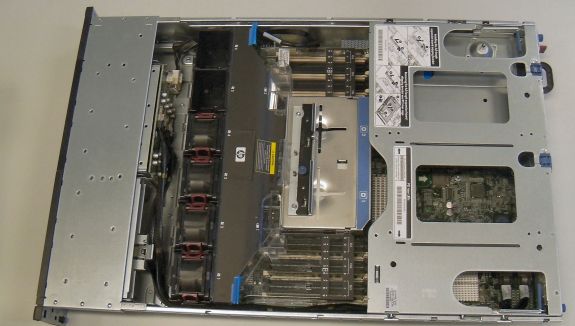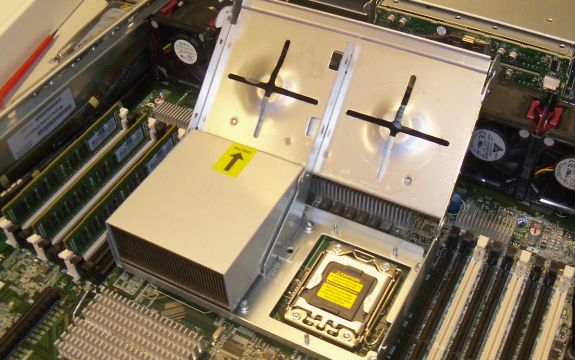Server Clash: DELL's Quad Opteron DELL R815 vs HP's DL380 G7 and SGI's Altix UV10
by Johan De Gelas on September 9, 2010 7:30 AM EST- Posted in
- IT Computing
- AMD
- Intel
- Xeon
- Opteron
HP Proliant DL380 G7
| CPU | Two Xeon X5670 at 2.93GHz |
| RAM | 15 x 4GB Samsung 1333MHz CH9 |
| Motherboard | HP proprietary? |
| Chipset | Intel 5520 |
| BIOS version | P67 |
| PSU | 2 x HP PS-2461-1C-LF 460W HE |
The 15x 4GB is not a typo. We wanted to give each server the same amount of memory while making sure that each system was working at the highest performance. In other words, each memory channel had be populated. In case of the HP DL380 G7 we populated the nine DIMMs of the first CPU, and the second CPU only got six DIMMs. This way each channel was populated, and the amount of memory (60GB) was close enough to the other systems (64GB). The extra power that one DIMM would add to the power consumption is taken in to account in the energy measurements. A DDR3 DIMM adds about 4W on average while being active.
The HP DL380 line is probably the most popular server in the world. It comes standard with four fans and one CPU. If you buy a second CPU, two fans are added to the design. The DL380 has eight 2.5 inch drive bays.

HP’s engineers have implemented quite a few great ideas: the number of sensors and the integration with the management software (ILO) is great. Lots of LEDs at the front panel give feedback to the administrator. The HP server ships with a PSU that is 92% or 94% efficient, and thus qualifies as an “80PLUS Gold” PSU. The second redundant PSU can be configured as being "cold redudant", not consuming a single watt when it is not necessary.
The CPU heatsinks can be placed on the CPU, and you simply have to close a metal “heatsink cage” to make sure that the heatsinks are applying the proper pressure on the CPUs. That makes replacing CPUs effortless and very safe.
But we are less enthusiastic about some of the “product differentiation choices”. For some weird reason, HP’s servers always ship with a few 1GB DIMMS even if you have customized the server with several tens of gigabytes. The servers is delivered with eight dummy drive bays, and you only get the functional drive bays for each disk that you order. The I/O cage is only fitted with one riser card: another optional riser card must be ordered separately. While this makes sense for HP as a vendor, in our opinion it is not customer friendly. This leads in many cases to extra deployment delays as buyers have to order something extra after the server has arrived.












51 Comments
View All Comments
pablo906 - Saturday, September 11, 2010 - link
High performance Oracle environments are exactly what's being virtualized in the Server world yet it's one of your premier benchmarks./edit should read
High performance Oracle environments are exactly what's not being virtualized in the Server world yet it's one of your premier benchmarks.
JohanAnandtech - Monday, September 13, 2010 - link
"You run highly loaded Hypervisors. NOONE does this in the Enterprise space."I agree. Isn't that what I am saying on page 12:
"In the real world you do not run your virtualized servers at their maximum just to measure the potential performance. Neither do they run idle."
The only reason why we run with highly loaded hypervisors is to measure the peak throughput of the platform. Like VMmark. We know that is not realworld, and does not give you a complete picture. That is exactly the reason why there is a page 12 and 13 in this article. Did you miss those?
Per Hansson - Sunday, September 12, 2010 - link
Hi, please use a better camera for pictures of servers that costs thousands of dollarsIn full size the pictures look terrible, way too much grain
The camera you use is a prime example of how far marketing have managed to take these things
10MP on a sensor that is 1/2.3 " (6.16 x 4.62 mm, 0.28 cm²)
A used DSLR with a decent 50mm prime lens plus a tripod really does not cost that much for a site like this
I love server pron pictures :D
dodge776 - Friday, September 17, 2010 - link
I may be one of the many "silent" readers of your reviews Johan, but putting aside all the nasty or not-so-bright comments, I would like to commend you and the AT team for putting up such excellent reviews, and also for using industry-standard benchmarks like SAPS to measure throughput of the x86 servers.Great work and looking forward to more of these types of reviews!
lonnys - Monday, September 20, 2010 - link
Johan -You note for the R815:
Make sure you populate at least 32 DIMMs, as bandwidth takes a dive at lower DIMM counts.
Could you elaborate on this? We have a R815 with 16x2GB and not seeing the expected performance for our very CPU intensive app perhaps adding another 16x2GB might help
JohanAnandtech - Tuesday, September 21, 2010 - link
This comment you quoted was written in the summary of the quad Xeon box.16 DIMMs is enough for the R815 on the condition that you have one DIMM in each channel. Maybe you are placing the DIMMs wrongly? (Two DIMMs in one channel, zero DIMM in the other?)
anon1234 - Sunday, October 24, 2010 - link
I've been looking around for some results comparing maxed-out servers but I am not finding any.The Xeon 5600 platform clocks the memory down to 800MHz whenever 3 dimms per channel are used, and I believe in some/all cases the full 1066/1333MHz speed (depends on model) is only available when 1 dimm per channel is used. This could be huge compared with an AMD 6100 solution at 1333MHz all the time, or a Xeon 7560 system at 1066 all the time (although some vendors clock down to 978MHz with some systems - IBM HX5 for example). I don't know if this makes a real-world difference on typical virtualization workloads, but it's hard to say because the reviewers rarely try it.
It does make me wonder about your 15-dimm 5600 system, 3 dimms per channel @800MHz on one processor with 2 DPC @ full speed on the other. Would it have done even better with a balanced memory config?
I realize you're trying to compare like to like, but if you're going to present price/performance and power/performance ratios you might want to consider how these numbers are affected if I have to use slower 16GB dimms to get the memory density I want, or if I have to buy 2x as many VMware licenses or Windows Datacenter processor licenses because I've purchased 2x as many 5600-series machines.
nightowl - Tuesday, March 29, 2011 - link
The previous post is correct in that the Xeon 5600 memory configuration is flawed. You are running the processor in a degraded state 1 due to the unbalanced memory configuration as well as the differing memory speeds.The Xeon 5600 processors can run at 1333MHz (with the correct DIMMs) with up to 4 ranks per channel. Going above this results in the memory speed clocking down to 800MHz which does result in a performance drop to the applications being run.
markabs - Friday, June 8, 2012 - link
Hi there,I know this is an old post but I'm looking at putting 4 SSDs in a Dell poweredge and had a question for you.
What raid card did you use with the above setup?
Currently a new Dell poweredge R510 comes with a PERC H700 raid card with 1GB cache and this is connect to a hot swap chassis. Dell want £1500 per SSD (crazy!) so I'm looking to buy 4 intel 520s and setup them up in raid 10.
I just wanted to know what raid card you used and if you had a trouble with it and what raid setup you used?
many thanks.
Mark
ian182 - Thursday, June 28, 2012 - link
I recently bought a G7 from www.itinstock.com and if I am honest it is perfect for my needs, i don't see the point in the higher end ones when it just works out a lot cheaper to buy the parts you need and add them to the G7.